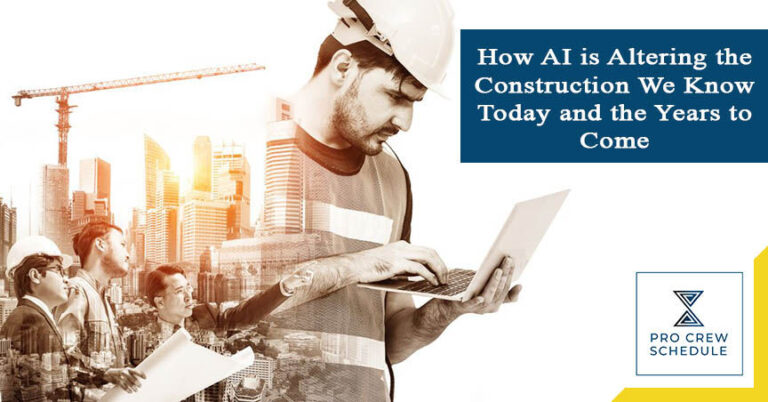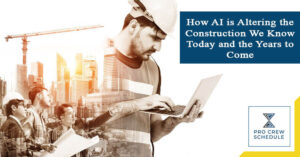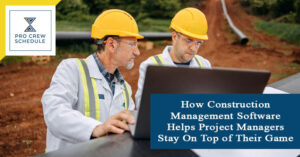When people hear the word “Artificial Intelligence” or “AI,” the first thing that comes to mind are robots that look and act like humans but are completely void of humanity. However, the concept of artificial intelligence changed throughout the years – it evolved from something dangerous to something that can be helpful, even in the construction industry.
The introduction of AI to the world received polarizing remarks around the globe. Some people believe it harms the workforce, as jobs can be replaced with technology. People on the other side of the fence, however, think that it can make jobs more efficient and faster, reducing administrative work that can be automated. While both concerns are valid, it’s worth noting that when implemented properly, AI can positively impact the workplace, especially in managing construction.
What is Artificial Intelligence?
Artificial intelligence is a concept that is typically merged with two more close topics – machine learning and deep learning. Before I dive deep into AI, let’s first distinguish the difference between the three.
Artificial intelligence, commonly known as AI, is a broad field in computer science (CS) that involves creating smart machines that can automatically perform tasks that otherwise originally require human intelligence. These tasks include recognizing patterns, performing based on experience, and understanding natural language based on data.
Machine learning, on the other hand, is a specific subset of AI. It is defined by the ability to learn as one of the most fundamental attributes of intelligent behavior, which means that machines can learn and predict possible outcomes on their own. Instead of people programming them, they utilize software with built-in algorithms that allow them to make predictions based on their data analysis. For instance, a machine can inform you randomly that it needs preventative servicing.
Lastly, deep learning is a specific subset of machine learning, wherein the machine is programmed to learn and formulate decisions based on artificial neural networks they possess—specifically, deep neural networks (DNN). Deep learning is commonly used for handling huge amounts of complex data.
Why is Artificial Intelligence Relevant in the Construction Industry?
In the past few years, digital collaboration and technology such as construction scheduling software have accelerated in the industry. Still, it’s difficult to find the right resources to complement the digital tools already implemented on-site.
This is where AI comes into play.
Combined with AI technology, construction management software will propel the industry forward, upgrading outcomes for workers, subcontractors, trade professionals, and end clients.
If you’re interested in getting on board, using AI in construction could help you improve productivity, quality, safety, and other measures vital to your success. AI can take over repetitive duties and help with planning and design, allowing the workers to spend time refining their expertise and honing their creativity. Beyond that, AI can help construction teams and companies make detailed predictions, streamlining workflows in the years to come.
Below, we’ll provide a brief look into the relevance of AI in construction and how it can improve the industry in the long run.
What are AI Tools and Technology that Can Be Implemented in Construction?
Now that we’ve defined the close concepts of AI and the value it can bring to the construction industry, let’s look at some of the AI tools and technology in the market. Based on your objectives, you can consider the following to be implemented in your business.
1. Constru
Constru utilizes advanced computer vision and AI to improve and streamline overall construction project management. Designed for project managers and superintendents, this solution can help users pinpoint specific differences in construction plans from actual build-on-site by automatically comparing BIM to the 360° images of the construction job site. This makes it easier to identify misalignments and reduce rework from the get-go.
Once Constru gives you a list of discrepancies on site, you can inject this data into a construction crew dispatch software such as Pro Crew Schedule so an appointed team member can correct mistakes on the actual job site as early as possible. This can reduce not only rework but also the huge amount of time and money that will be spent on repairs when detected late.
2. viAct
viAct is a company dedicated to providing comprehensive observation of construction projects, simultaneously leveraging advanced AIoT (Artificial Intelligence of Things) in automating the tracking of productivity, safety, and maintenance. viAct makes this possible by powering job-site cameras with scenario-based AI tools.
The technology lets any job site camera with scenario-based AI, making capturing productivity or safety issues in real-time easier. ViAct then shows these data in a user-friendly dashboard so teams can quickly pinpoint—and act on as soon as possible—any issues around non-compliance.
3. EarthCam
EarthCam is a forerunning provider of live camera technology, services, and content. Construction teams adopt EarthCam to monitor the movement in their projects. Whether it’s live streaming video webcam content or construction site time-lapse, EarthCam gives you a comprehensive ecosystem of visual data content to enhance your project management and promote worksite transparency, even if you’re not on-site.
EarthCam also features state-of-the-art Edge Computer Vision and server-side AI that surpasses the visual capabilities of human observers. This technology uses AI Object Detection to program automatic alerts, tags, and overall visualizations. Meaning teams can reduce time spent manually observing the job site and more energy taking action that AI cannot do.
4. StructionSite
Always remote but want to have visual documentation of your construction project everywhere you go? Then StructionSite is the AI tool for you. With this technology, you can easily capture the progress of your job site with its built-in feature that can capture 360 photos, standard photos, and videos that enable your team to map out your floor plan.
Once the photos and videos are properly documented, StructionSite can help you find photos easily with AI-enabled capabilities, allowing you to create a virtual construction site that your team can access anywhere.
5. Versatile
Proud of delivering value, insight, and learnings critical in achieving the best in the construction industry, the Versatile AI and IoT platform transforms any construction site into a smart and data-gathering workplace. Its CraneView feature enables the digitalization of construction job sites through automatic capture analysis of the project’s floor data. Since it can be easily integrated into existing systems, it is easy to use while providing a dependable solution for automated construction data collection.
6. BuildStream
The combination of AI and the Internet of Things (IoT) provides BuildStream, which integrates telematics records and data into a central platform to help large-scale construction projects increase the utilization of tools and equipment and save money. This AI tool then creates a digital solution to speed up and make the employees work more efficiently, from hiring qualified people to construction projects and international work. BuildStream was created on the belief that increasing access to global talent and engineering teams is vital to rebuilding our infrastructure in the coming years.
7. AirWorks
An aerial mapping company, AirWorks, helps land developers and construction engineers survey multiple construction sites in their timely and critical planning. AI-powered software separately converts 2D and 3D aerial records into CAD models using proprietary machine learning technology. In doing so, Airworks increases the productivity of its customers’ services through a smart process from data to deliverables.
8. Caidio
Providing AI-based software to improve construction productivity and quality, Caidio helps customers increase quality, reduce construction time and costs. With more than 30 years of expertise in automated industrial measurement, the company enables the unparalleled power of Intelligent Concrete to transform the construction process with quality assurance.
Key Takeaway
From everything we have discussed, the clear bottom line is Artificial Intelligence can be an expensive investment for construction companies, but the ROI is impactful in the long run. Managers at construction companies must prioritize investment, focusing on areas where AI can have the biggest impact on their company’s unique services. Early movers will set the direction of the construction industry and benefit in the short and long term.
Despite the predictions of global job losses in various industries, AI is unlikely to substitute the human workforce in construction. Rather, it will change the business models in the construction industry, reduce worksite injuries, reduce expensive errors, and make construction crew management more efficient. Construction will remain a human business from day one until the future. We need our workers’ expertise, skills, and innovation to ensure a successful future. We can use AI as just another tool that will let our construction talents and skills be highlighted. Using AI wisely can help us maximize human creativity and innovativeness in managing construction now and in the years to come.







